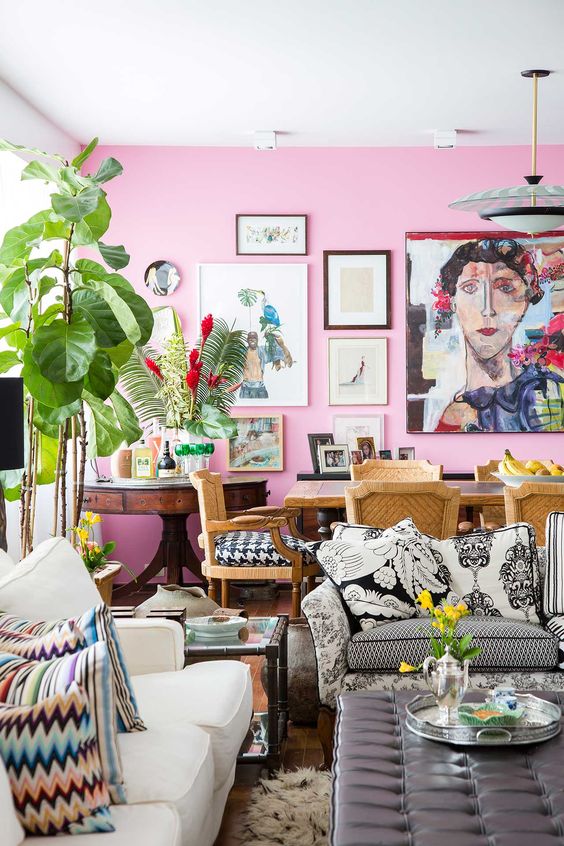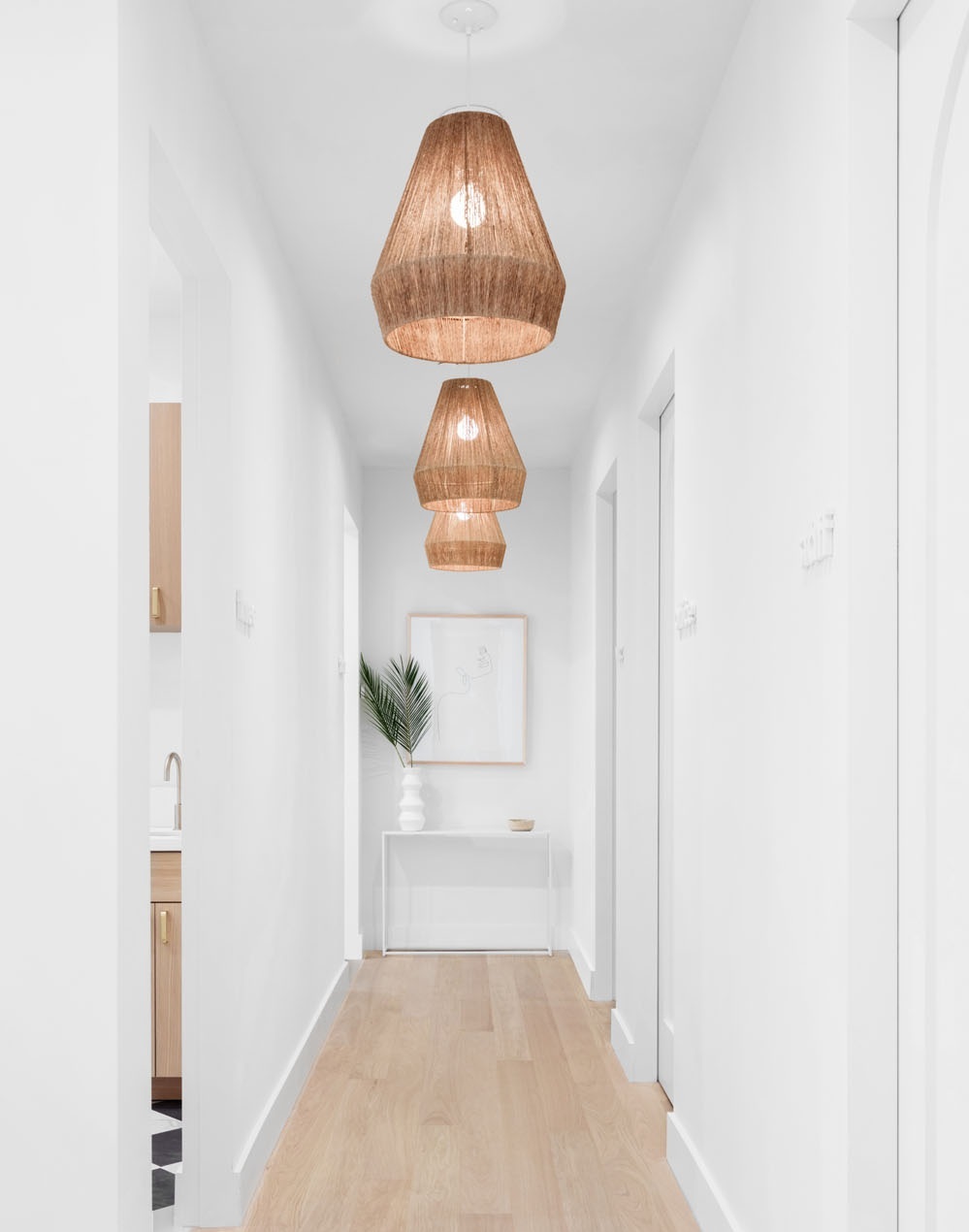The Serenity of Maximalism and Minimalism Alike
If you walk through the rooms of my home you will find there is much to take in. Prints, plants, keepsake boxes, old suitcases, piled up books, restored light fixtures, empty frames, and hanging tea cups. With such an array, I am in a happy place here. There are many ever-changing details, and finding enjoyment in the evolution, I have come to know I am a maximalist.
a Definition of maximalism:
A design style that incorporates copious amounts of texture, color, and pattern to create a bold visual impact. more is more.
I acquired this affinity for the maximalist style from my grandparents. My Grandpa Frank and Grandma Laura kept, in my mind, the most interesting home in Capitol Hill. There was something about the way prints layered upon one another in rugs, pillows, and artwork, together forming a symmetry and synergy so engaging and interesting. It felt significant because each originated from a different part of the world. I remember spending time looking at the clay sculptures lined along their sash windows, many holding sprawling plants, and my hands would delicately touch the porcelain vases before playing one of their wooden flutes. Everything they owned seemed to have a story and when my introversion occasionally kicked in, I would slip by the family and re-acquaint myself with those stories, some told to me and more imagined, visions of how my own adventures might have brought this flute home.
Fast forward 13 years and I am walking through my own home re-acquainting myself with the photographs and artwork I’ve collected. Without any particular cause, I start moving furniture around. I feel that impulse, unsettled by the settled dust, and I know it’s time to explore what other kinds of evolution this room can experience. It is cathartic for me, like an act of peaceful awakening to the environment I return to every day. To some, the existence of so much stuff, which it can all be argued as, is too overwhelming. I have friends who have admired my aesthetic but know full well that they could not live in it for long. Here is where I am fascinated by people’s different design inclinations. I would say my maximalism seeks to reach the full depths of that style. In other words I am inspired by spaces like these:
Each of which light up my senses like nothing else. And yet I do find tranquility in neutral paint and negative space, a respect for minimalism and the calm its simplicity creates.
a defintion of minimalism:
a design style and lifestyle that encourages simplicity through nominal accouterments (clothing, accessories, possessions) and elements of design without heavy decoration - spacious with few furniture and less detail. less is more.
Minimalism is a beautiful type of design. I do believe such simplicity creates an appreciation for important elements beyond the physical, beyond the things that can accumulate on the shelves without notice. The things that are shown are significant and cohesive pieces that do not compete with one another. I suppose that is where the overwhelming maximalism seems a fault. With the shear quantity of items, there is so much to take in, and with it, a risk of thoughtlessness or disarray. The most important element, whether your physical items are vast or minute, is intention. That visual demand naturally formed by the gallery walls and multiple prints is not frivolously created. It is meant to solicit conversation in a valuable way, just as an environment created on the premise of minimalism would. The single or few pieces of art evoke immense personal value when they are intentionally placed.
So, these seemingly dichotomous styles; I wonder if the two must be mutually exclusive in design. Can one be a minimalist in a particular context and a maximalist in another? I am picturing someone whose home is serene in its simplicity, nothing sits or hangs in excess, but the rooms are filled with the loudest music, chaos in sound bouncing off one wall to be absorbed by the other. Perhaps the singular dramatic detail encompasses the entire room, the impression very maximalist, but the plumbing and other finishes are muted and simplistic. I can imagine co-existence in a compartmentalized way too. Designated spaces for different moods to thrive, the creative space for new thoughts is calm and uncluttered. It is really about personal preference because it’s easy to assume that serenity is only found in minimalism and chaos in maximalism. Who is to say though that piles of books do not denote peace? That a wall covered corner to corner with frames impedes our ability to to be fully present?
immersion of two design worlds
These two shots are from the Facile Spa in Pasadena, CA. My first impression of the bathroom was bold, but the floating vanity and frameless mirror give an essence of reservation against the loud print. This differs greatly from the all white and light wood design of the hallway. Far from boring, the contrast of the clean white against the warm wood, with the woven textures of the large pendants gives the eye simultaneous rest and interest-a great effect for a space meant to be a transition into the other rooms. In this Spa’s design I see minimalism and maximalism find cohesion.
know yourself & create an environment to reflect it
So it comes back to the question, what drives our design inclinations? What makes someone inclined to strip their environment of every ornamentation and find the perfect ease, comfort, and vitality of a single photograph with a calm grey painted background? While another seeks respite in a room of mismatched pews and an installation of trees jutting from the wall, shadows cast by their branches, teasing your mind to believe your feet are not really planted on the ground…you are actually upended among the books. Woah, I am a maximalist in my words too. But I go into such detail because of Estelita’s Library, where in the pew at a writer’s workshop (held by Jeff Cheatham of the Seattle Urban Book Expo), I mulled over this post and concept. The tiny reprieve of books reminded me of the power of our environments and what sticks with us as we enter and leave them.
They are reflections.
Our environment informs us of our values and communicates our needs. It expresses what we want to be reminded of and shows the way toward that lifestyle. Design is, or at least can be, a reflection of our internal selves. That reflection is of course layered and not always easy to put one title to, because we are complicated evolving beings, but it is certainly an inspiration and an insight.
You want your environment to foster your passions, to be the place to create and regain clarity in. Here are some questions that I have found useful to begin that exploration.
What about an environment creates a sense of calm for you?
What is the function of the space?
Do you want to be able to build upon that space stylistically or create it and leave it alone?
Do the pieces you have collected serve you either in function or joy?
I have come to think there is another important element to creating your preferred environment.
synonym: joy
Though I can’t answer in one post what I’m only beginning to understand, I can say I always seem to come back to a synonymous relationship; knowledge of yourself is knowledge of the joy in your core. I believe joy exists within our deepest internal selves. You can pick up on it in the excitement someone emanates as they discuss a job or hobby or interest. You can recognize within yourself, a reoccurring idea that makes you dream and an urge in your spirit to act upon it. It can last years. It can lay dormant until, at the most unexpected time, it reveals itself again. I don’t think it ever goes away. The key to holding onto it, knowing it, and in so doing know yourself, is to build your environment around it.
I must also reference a magical book that really pushed me to reflect upon my environment. It is the Life-Changing Magic of Tidying Up: the Japanese Art of Decluttering and Organizing by Marie Kondo. It is an incredibly thoughtful guide to a minimalist lifestyle, and more deeply, to the lifestyle of intention and joy. Kondo talks about how the process of tidying up allows mental clarity and inspires joy because her clients are “surrounded by the things they love” (p.5). Her focus on joy reinforced the synonymous relationship I kept envisioning and it made sense. Why give room to those things that don’t make you happy? It clutters not only your physical but your mental space too.
“Take each item in one’s hand and ask: “does this spark joy?” If it does, keep it. If not, dispose of it.” (p.41)
balance
Remember when I said everything in my Grandparents home had a story? I try to emulate that daily, I want nostalgia to sweep through every box and bowl and random note; memories for me, explorations for you. But nostalgia doesn’t have to run rampant to where you lose the significance, because I also believe that where each thing has a story, it also has an intention behind its place. It serves a purpose, not necessarily practical, but always honest and fulfilling. Its purpose can be shear beauty, an admiration for craft and form made by the influences you want to see every day.
But like Marie Kondo said, letting go is also a deeply important act. If an object does not serve you or the mass of their accumulation elicits stress then reigning in that maximalist style would be good. The same can be said of the opposite. If the simplicity of your space feels wanting, consider what element of joy is missing; color? accents? pieces that retain memories? More surfaces to create upon? It is intention that the expanse of your style should be based upon.
The last important detail is your space is your own. Know that design never has to remain one way, it can change nimbly or be firm and resolute. So long as you see that your relationship to it elicits joy, pursue the minimalist or maximalist in you.
Settle into your serenity.
.Kels.













